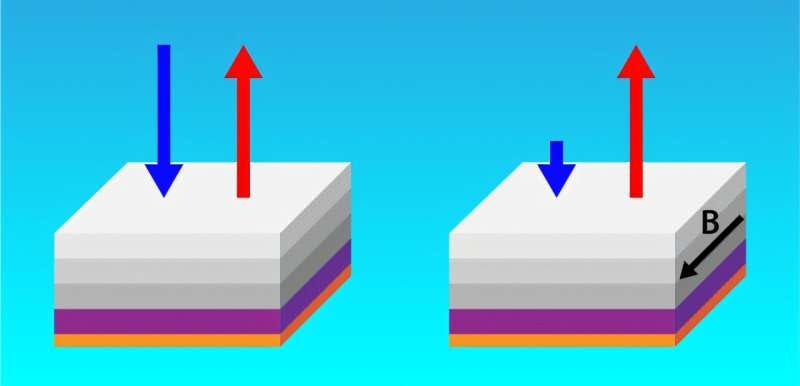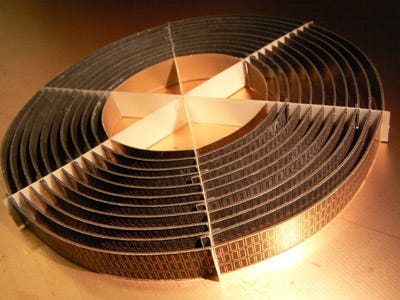This metamaterial emits more radiation than it absorbs!
Researchers have synthesized a material which seemingly violates the Kirchhoff's law of Thermal Radiation
Greetings, fellow Bohron.
For centuries, scientists thought they fully understood how objects emit heat as infrared radiation. But a fascinating breakthrough in physics is now challenging those traditional limits.
A Breakthrough Has Been Achieved…
A week ago, a new paper was published in Physics Review Letters, titled Observation of Strong Nonreciprocal Thermal Emission written by Zhenong Zhang, Alireza Kalantari Dehaghi, Pramit Ghosh, and Linxiao Zhu, all researchers at the Department of Mechanical Engineering, The Pennsylvania State University.
They have designed a metamaterial that emits more infrared light than it absorbs, seemingly a violation of the well-established Kirchhoff's law of thermal radiation. Let’s dive into the physics first.
The Physics

Kirchhoff's law of thermal radiation
In the 19th century, physicist Gustav Kirchhoff formulated a principle:
At thermal equilibrium, an object’s emissivity (how efficiently it emits radiation) equals its absorptivity (how efficiently it absorbs radiation) at each wavelength.
This law has guided scientists for over 150 years. But it also seemed to impose a natural limit: you couldn’t design a material that emits more infrared radiation than it absorbs under the same conditions.
Reciprocity
The rate of electromagnetic radiation emitted by a body at a given frequency is proportional to the rate at which the body absorbs radiation at that frequency, a property known as reciprocity. Thus, a surface that absorbs more red light thermally radiates more red light.
Metamaterial
Remember I mentioned them in 3 ways to become invisible?
A metamaterial is any artificially engineered material with unconventional properties not found in nature.
The natural properties of a material are deliberately and consciously altered by introducing tiny implants into a substrate. This exploitation of the properties causes metamaterials to interact with electromagnetic radiation in unnatural ways.

Past Attempts
For many years, researchers have been designing methods that could allow materials to break reciprocity.
In 2023, researchers at the California Institute of Technology successfully achieved nonreciprocity. They took a layer of the magneto-optical material indium arsenide (InAs) and subjected it to a powerful magnetic field of about 1 T. However, the effects observed were weak and highly conditional.
A magneto-optical material is a special type of material whose optical properties—such as absorption, reflection, transmission and polarization—can be changed or controlled by applying a magnetic field.
A New Approach
In the new multilayered design, Zhenong Zhang and his colleagues succeeded in doubling the nonreciprocity effects. Their accomplishment is being considered the first reported observation of "strong" nonreciprocal thermal emission.
Their metamaterial consists of five layers of electron-doped indium gallium arsenide (InGaAs), each 440 nm thick.
Doping is a process in which a small number of foreign atoms (called dopants) are intentionally added to a pure material (usually a semiconductor like silicon, germanium, or compounds like indium arsenide) to change its electrical, optical, or magnetic properties.

The doping concentration increased as the depth increased. The InGaAs layers were then transferred to a silicon substrate.
A substrate is basically the base material or surface on which other materials, structures, or layers are built or deposited.

The sample was then heated to 540 Kelvin temperature and kept in a magnetic field of magnitude 5 T. This configuration was studied with a custom-designed angle-resolved magnetic thermal emission spectroscopy (ARMTES) set up.
ARMTES is an experimental technique scientists use to study dependance of the emission of thermal radiation by a material in the presence of magneitic field.
The nonreciprocity of the material was measured over a wide range of angles and a broad range of infrared wavelengths (13-23 microns). The system exhibited twice the effect previously reported.
What happens inside?
But how was the material able to bend reciprocity to such a great effect? The secret lies in the engineering of their metamaterial.
They did this by:
1️⃣Designing nano-scale resonators in the metamaterial that couple thermal vibrations (phonons) with electromagnetic modes more effectively.
2️⃣Breaking certain symmetries in the structure to create asymmetric emission (more in one direction than the opposite).
3️⃣Exploiting nonequilibrium conditions, so the system locally emits more strongly than its equilibrium absorptivity would suggest.
This doesn’t violate Kirchhoff’s law in its strictest form (which assumes complete thermal equilibrium and reciprocity), but it goes beyond traditional expectations by carefully engineering how energy is redistributed and radiated in practice.
Final Words…
"Our experiment for the first time realizes strong nonreciprocal emission, with nonreciprocity as high as 0.43, which is much higher than nonreciprocity in literature."
- Zhenong Zhang
The emission and absorption properties of materials are vital to numerous scientific and engineering applications. If we can control such characteristics of a material, we can create advances in solar energy harvesting, thermal cloaking devices, and other technologies.
For example, such a nonreciprocal thermal emitter can be placed above a solar thermophotovoltaic cell. This would channelize the thermal radiation in one preferential direction and help harvest more of the sun's energy.

According to researchers, progress in this field may lead to breakthroughs in new classes of thermal diodes and transistors, improved thermophotovoltaic designs, and other heat-management technologies.
References:
Observation of Strong Nonreciprocal Thermal Emission - Physical Review Letters, American Physical Society
Kirchhoff's law of thermal radiation - Wikipedia
Better energy harvesting with 'law-breaking' device - phys.org
You May Also Read:
3 ways to become invisible
You can’t depend on your eyes when your imagination is out of focus. - Mark Twain






Pennsylvania State University. My alma mater!